ECON 430: Case Study on Money, Banking, Inflation, and Interest
VerifiedAdded on 2022/11/13
|9
|1327
|178
Case Study
AI Summary
This case study analyzes the issues related to money and banking in the United States, focusing on the period from 2009 to 2019, with a specific examination of trends from May to July 2019. The study uses economic concepts such as inflation, interest rates, and monetary policy, with a particular emphasis on the Federal Reserve's actions and their impacts. It explores the relationship between the federal funds rate and inflation, noting the recent decrease in the interest rate and its potential effects. The analysis incorporates both theoretical explanations and graphical representations of data to illustrate these economic issues, offering insights into the dynamics of money and banking within the US economy. The study concludes by highlighting the interconnections between monetary policy, inflation, and interest rates, and their combined influence on economic growth and stability. The student has used data from credible sources like Tradingeconomics.com, The Economic Times, and Federal Reserve to support their claims.
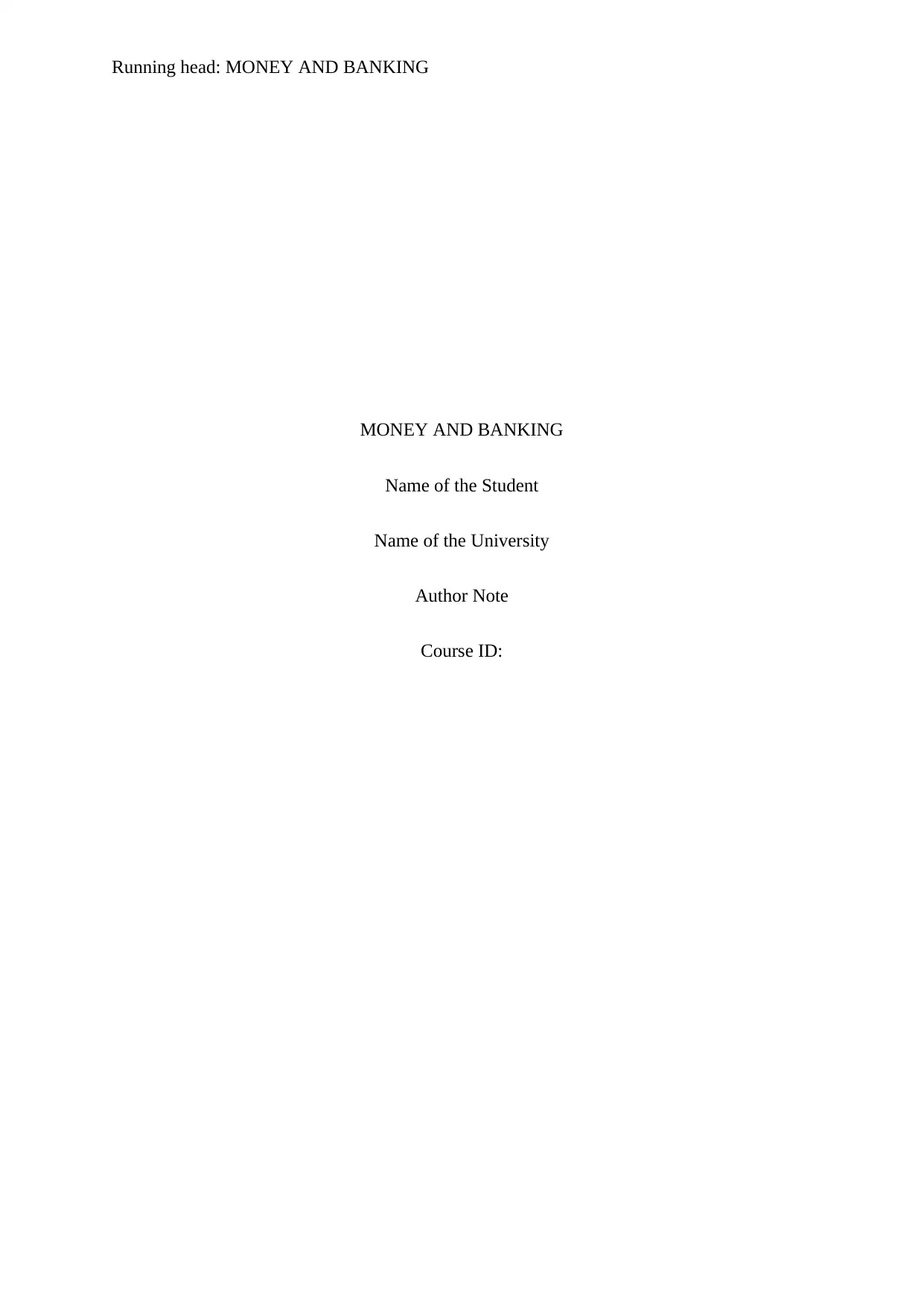
Running head: MONEY AND BANKING
MONEY AND BANKING
Name of the Student
Name of the University
Author Note
Course ID:
MONEY AND BANKING
Name of the Student
Name of the University
Author Note
Course ID:
Paraphrase This Document
Need a fresh take? Get an instant paraphrase of this document with our AI Paraphraser
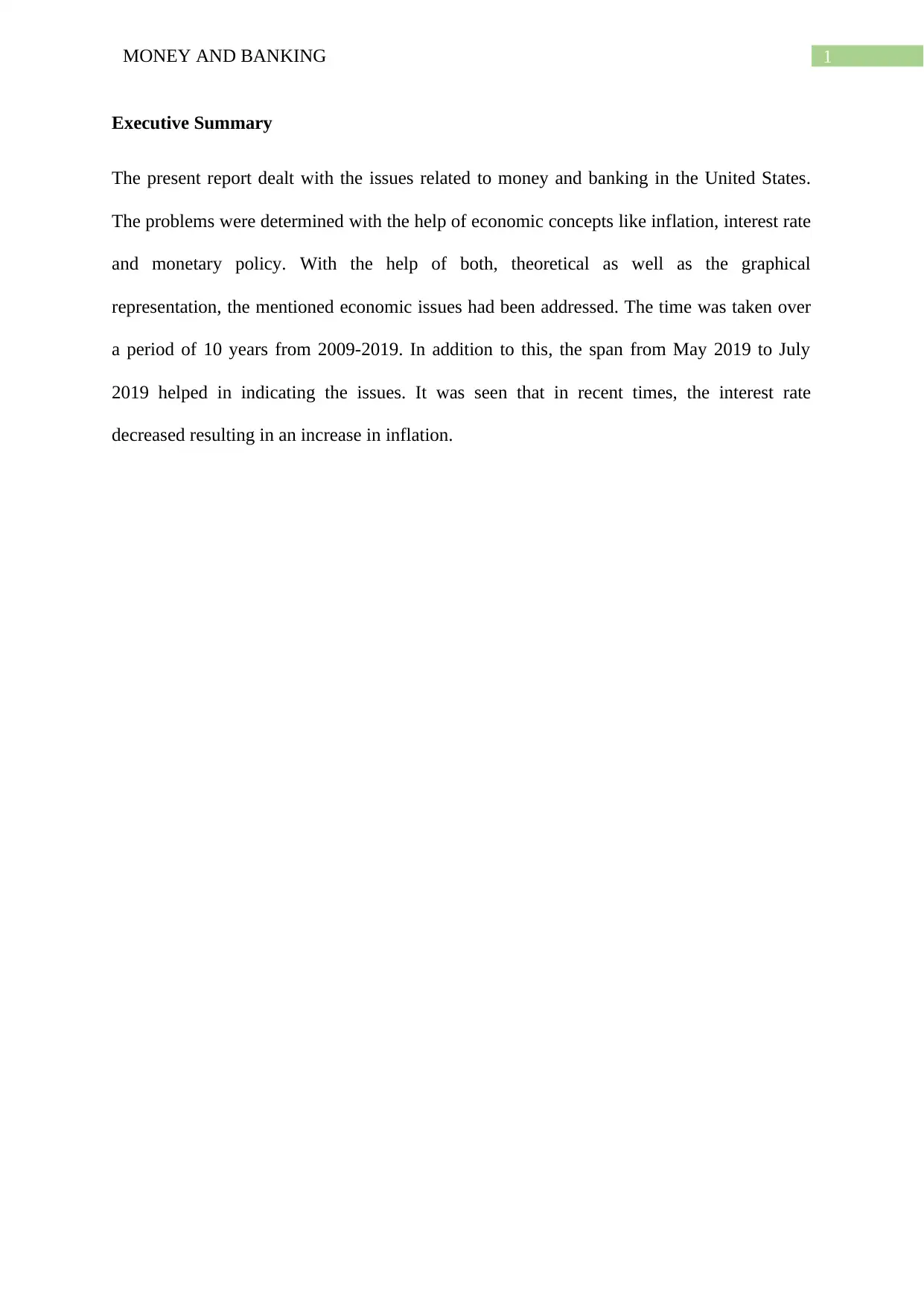
1MONEY AND BANKING
Executive Summary
The present report dealt with the issues related to money and banking in the United States.
The problems were determined with the help of economic concepts like inflation, interest rate
and monetary policy. With the help of both, theoretical as well as the graphical
representation, the mentioned economic issues had been addressed. The time was taken over
a period of 10 years from 2009-2019. In addition to this, the span from May 2019 to July
2019 helped in indicating the issues. It was seen that in recent times, the interest rate
decreased resulting in an increase in inflation.
Executive Summary
The present report dealt with the issues related to money and banking in the United States.
The problems were determined with the help of economic concepts like inflation, interest rate
and monetary policy. With the help of both, theoretical as well as the graphical
representation, the mentioned economic issues had been addressed. The time was taken over
a period of 10 years from 2009-2019. In addition to this, the span from May 2019 to July
2019 helped in indicating the issues. It was seen that in recent times, the interest rate
decreased resulting in an increase in inflation.
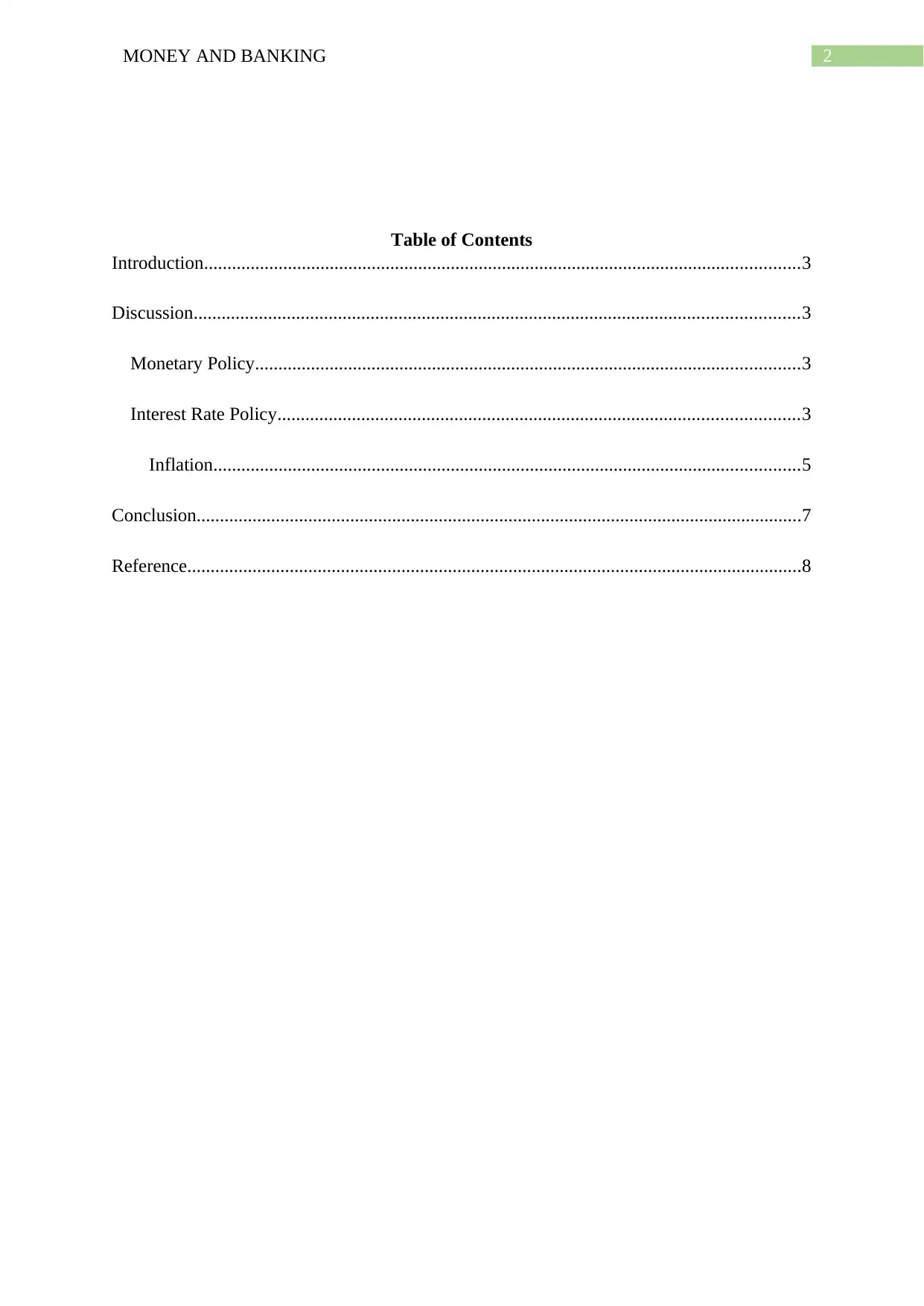
2MONEY AND BANKING
Table of Contents
Introduction................................................................................................................................3
Discussion..................................................................................................................................3
Monetary Policy.....................................................................................................................3
Interest Rate Policy................................................................................................................3
Inflation..............................................................................................................................5
Conclusion..................................................................................................................................7
Reference....................................................................................................................................8
Table of Contents
Introduction................................................................................................................................3
Discussion..................................................................................................................................3
Monetary Policy.....................................................................................................................3
Interest Rate Policy................................................................................................................3
Inflation..............................................................................................................................5
Conclusion..................................................................................................................................7
Reference....................................................................................................................................8
⊘ This is a preview!⊘
Do you want full access?
Subscribe today to unlock all pages.

Trusted by 1+ million students worldwide
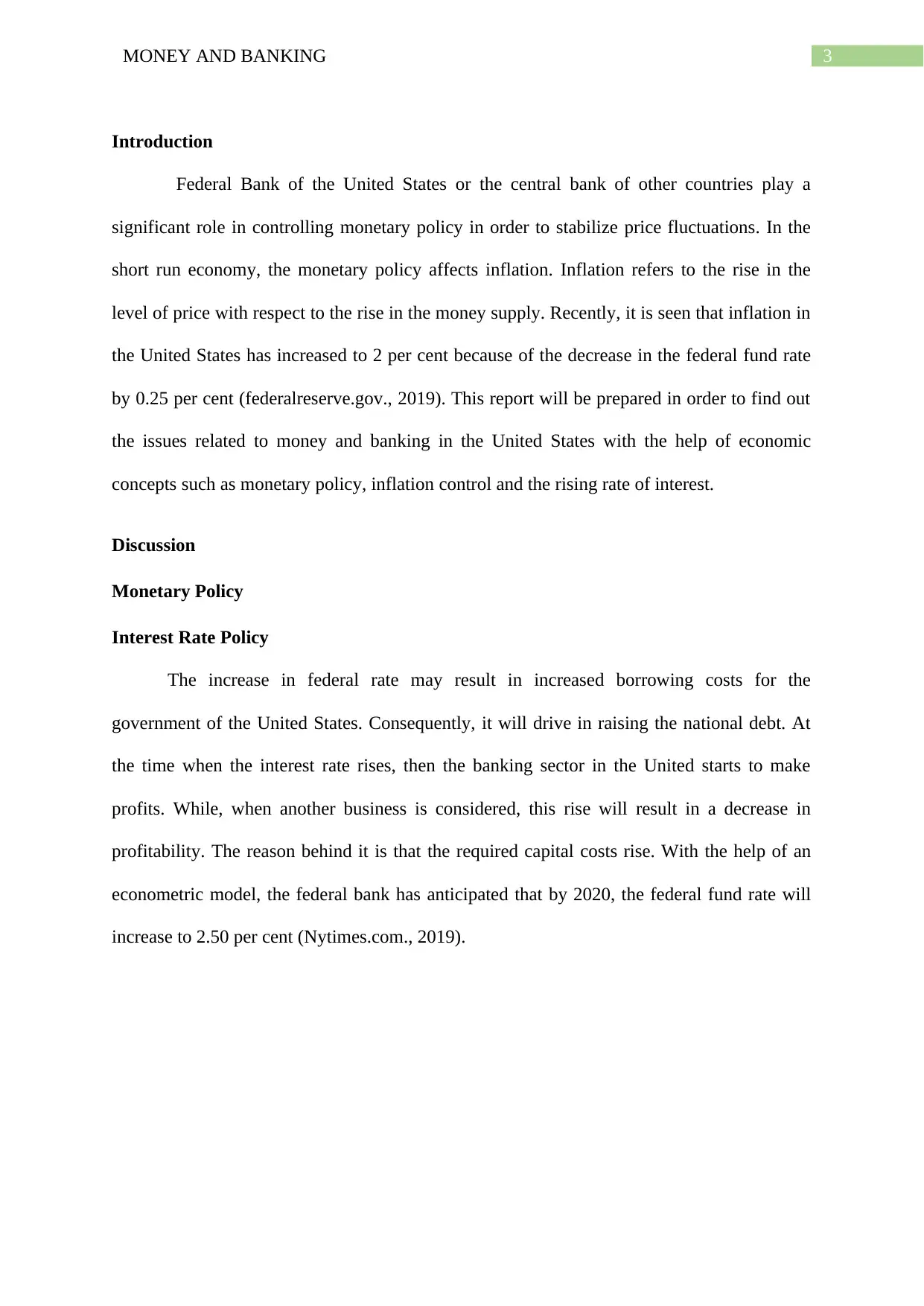
3MONEY AND BANKING
Introduction
Federal Bank of the United States or the central bank of other countries play a
significant role in controlling monetary policy in order to stabilize price fluctuations. In the
short run economy, the monetary policy affects inflation. Inflation refers to the rise in the
level of price with respect to the rise in the money supply. Recently, it is seen that inflation in
the United States has increased to 2 per cent because of the decrease in the federal fund rate
by 0.25 per cent (federalreserve.gov., 2019). This report will be prepared in order to find out
the issues related to money and banking in the United States with the help of economic
concepts such as monetary policy, inflation control and the rising rate of interest.
Discussion
Monetary Policy
Interest Rate Policy
The increase in federal rate may result in increased borrowing costs for the
government of the United States. Consequently, it will drive in raising the national debt. At
the time when the interest rate rises, then the banking sector in the United starts to make
profits. While, when another business is considered, this rise will result in a decrease in
profitability. The reason behind it is that the required capital costs rise. With the help of an
econometric model, the federal bank has anticipated that by 2020, the federal fund rate will
increase to 2.50 per cent (Nytimes.com., 2019).
Introduction
Federal Bank of the United States or the central bank of other countries play a
significant role in controlling monetary policy in order to stabilize price fluctuations. In the
short run economy, the monetary policy affects inflation. Inflation refers to the rise in the
level of price with respect to the rise in the money supply. Recently, it is seen that inflation in
the United States has increased to 2 per cent because of the decrease in the federal fund rate
by 0.25 per cent (federalreserve.gov., 2019). This report will be prepared in order to find out
the issues related to money and banking in the United States with the help of economic
concepts such as monetary policy, inflation control and the rising rate of interest.
Discussion
Monetary Policy
Interest Rate Policy
The increase in federal rate may result in increased borrowing costs for the
government of the United States. Consequently, it will drive in raising the national debt. At
the time when the interest rate rises, then the banking sector in the United starts to make
profits. While, when another business is considered, this rise will result in a decrease in
profitability. The reason behind it is that the required capital costs rise. With the help of an
econometric model, the federal bank has anticipated that by 2020, the federal fund rate will
increase to 2.50 per cent (Nytimes.com., 2019).
Paraphrase This Document
Need a fresh take? Get an instant paraphrase of this document with our AI Paraphraser
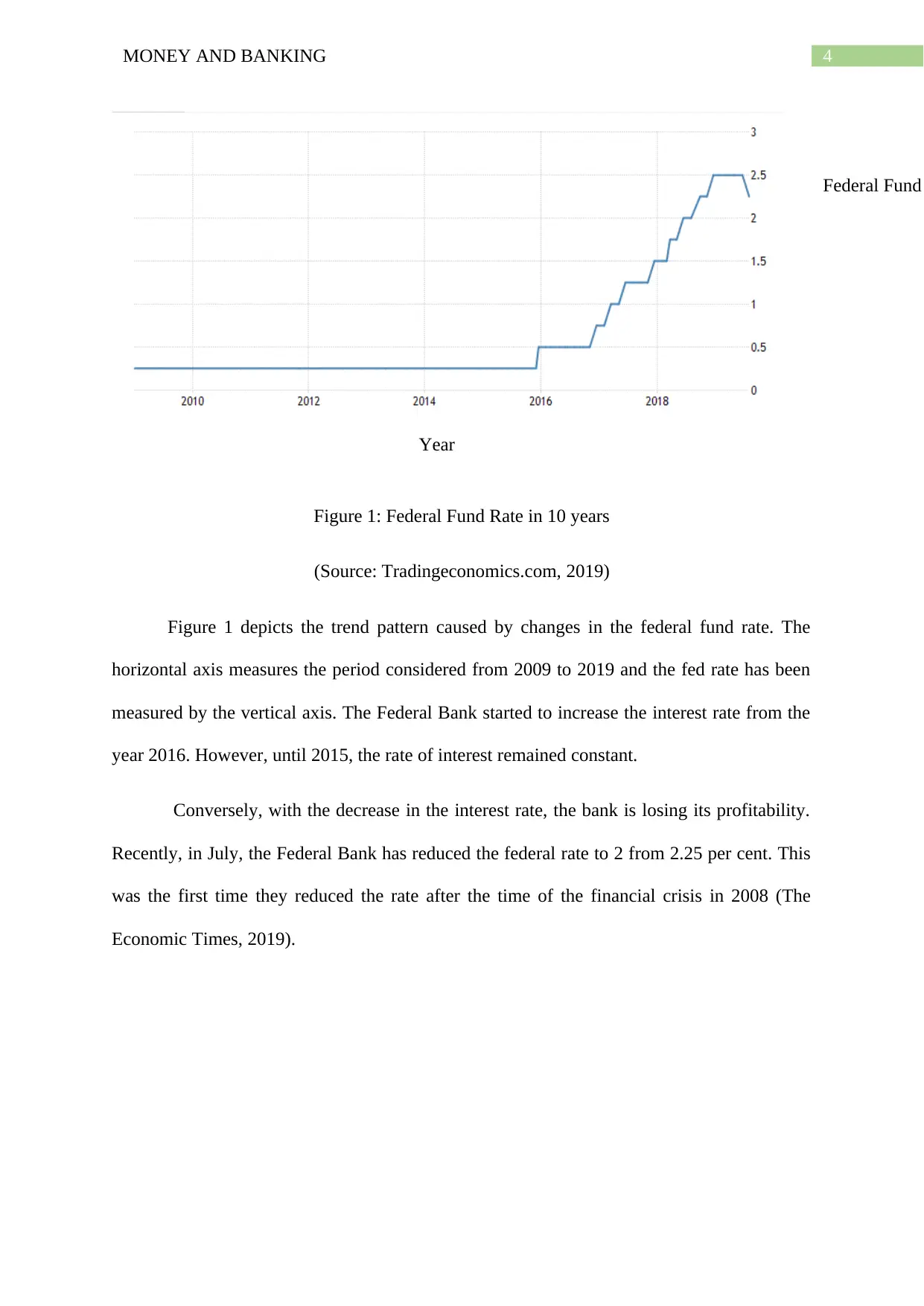
4MONEY AND BANKING
Figure 1: Federal Fund Rate in 10 years
(Source: Tradingeconomics.com, 2019)
Figure 1 depicts the trend pattern caused by changes in the federal fund rate. The
horizontal axis measures the period considered from 2009 to 2019 and the fed rate has been
measured by the vertical axis. The Federal Bank started to increase the interest rate from the
year 2016. However, until 2015, the rate of interest remained constant.
Conversely, with the decrease in the interest rate, the bank is losing its profitability.
Recently, in July, the Federal Bank has reduced the federal rate to 2 from 2.25 per cent. This
was the first time they reduced the rate after the time of the financial crisis in 2008 (The
Economic Times, 2019).
Federal Fund
Year
Figure 1: Federal Fund Rate in 10 years
(Source: Tradingeconomics.com, 2019)
Figure 1 depicts the trend pattern caused by changes in the federal fund rate. The
horizontal axis measures the period considered from 2009 to 2019 and the fed rate has been
measured by the vertical axis. The Federal Bank started to increase the interest rate from the
year 2016. However, until 2015, the rate of interest remained constant.
Conversely, with the decrease in the interest rate, the bank is losing its profitability.
Recently, in July, the Federal Bank has reduced the federal rate to 2 from 2.25 per cent. This
was the first time they reduced the rate after the time of the financial crisis in 2008 (The
Economic Times, 2019).
Federal Fund
Year
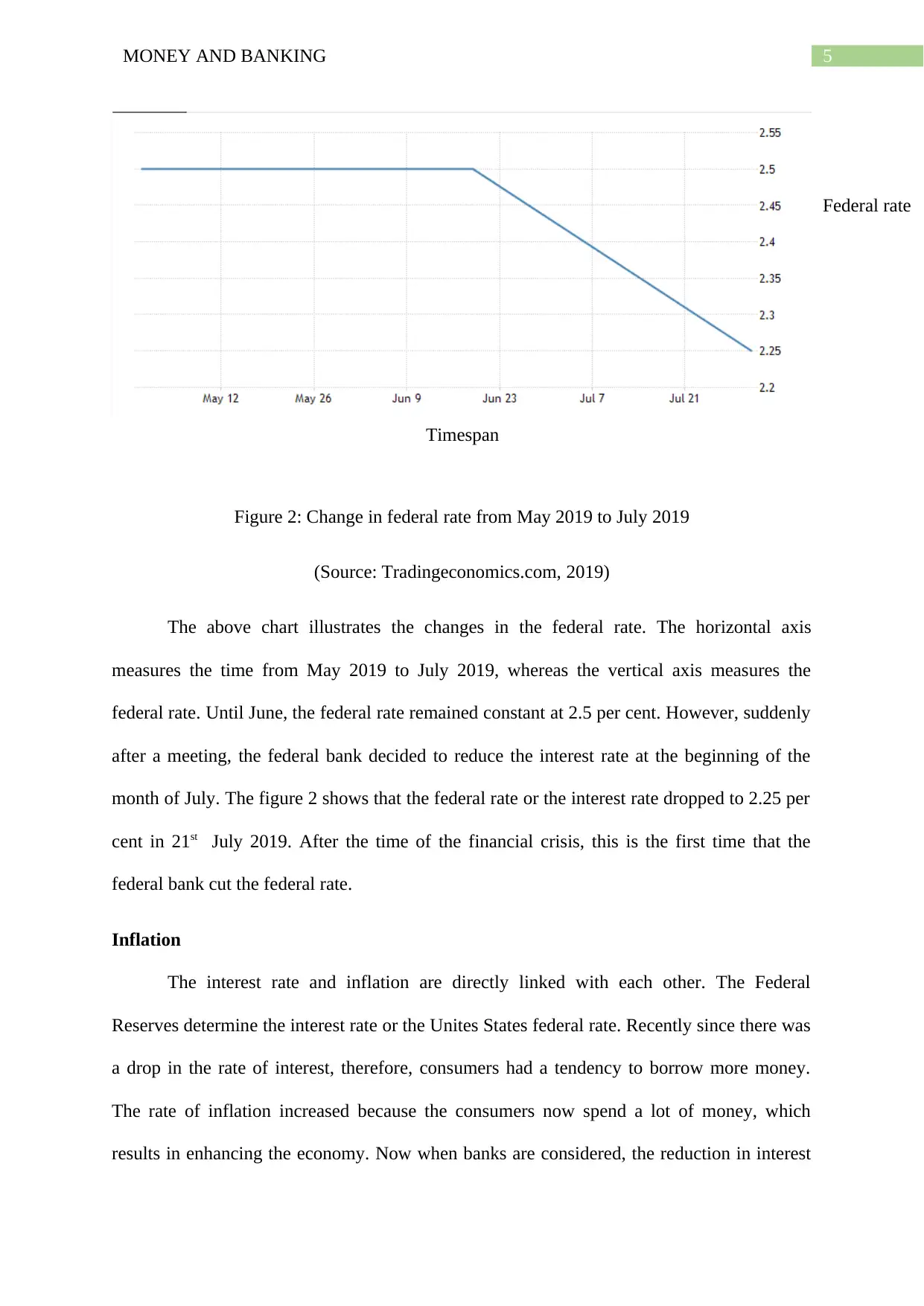
5MONEY AND BANKING
Figure 2: Change in federal rate from May 2019 to July 2019
(Source: Tradingeconomics.com, 2019)
The above chart illustrates the changes in the federal rate. The horizontal axis
measures the time from May 2019 to July 2019, whereas the vertical axis measures the
federal rate. Until June, the federal rate remained constant at 2.5 per cent. However, suddenly
after a meeting, the federal bank decided to reduce the interest rate at the beginning of the
month of July. The figure 2 shows that the federal rate or the interest rate dropped to 2.25 per
cent in 21st July 2019. After the time of the financial crisis, this is the first time that the
federal bank cut the federal rate.
Inflation
The interest rate and inflation are directly linked with each other. The Federal
Reserves determine the interest rate or the Unites States federal rate. Recently since there was
a drop in the rate of interest, therefore, consumers had a tendency to borrow more money.
The rate of inflation increased because the consumers now spend a lot of money, which
results in enhancing the economy. Now when banks are considered, the reduction in interest
Federal rate
Timespan
Figure 2: Change in federal rate from May 2019 to July 2019
(Source: Tradingeconomics.com, 2019)
The above chart illustrates the changes in the federal rate. The horizontal axis
measures the time from May 2019 to July 2019, whereas the vertical axis measures the
federal rate. Until June, the federal rate remained constant at 2.5 per cent. However, suddenly
after a meeting, the federal bank decided to reduce the interest rate at the beginning of the
month of July. The figure 2 shows that the federal rate or the interest rate dropped to 2.25 per
cent in 21st July 2019. After the time of the financial crisis, this is the first time that the
federal bank cut the federal rate.
Inflation
The interest rate and inflation are directly linked with each other. The Federal
Reserves determine the interest rate or the Unites States federal rate. Recently since there was
a drop in the rate of interest, therefore, consumers had a tendency to borrow more money.
The rate of inflation increased because the consumers now spend a lot of money, which
results in enhancing the economy. Now when banks are considered, the reduction in interest
Federal rate
Timespan
⊘ This is a preview!⊘
Do you want full access?
Subscribe today to unlock all pages.

Trusted by 1+ million students worldwide
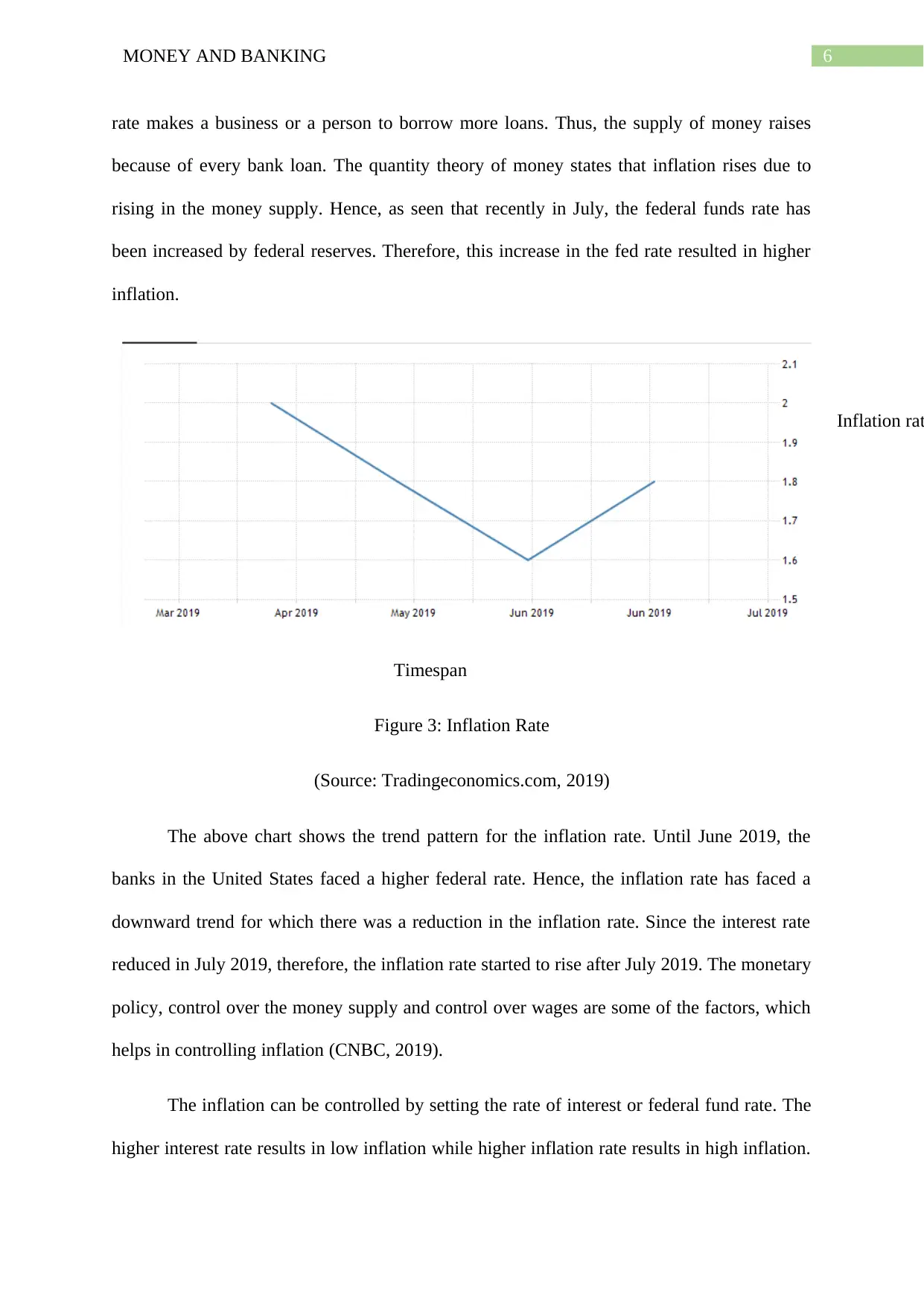
6MONEY AND BANKING
rate makes a business or a person to borrow more loans. Thus, the supply of money raises
because of every bank loan. The quantity theory of money states that inflation rises due to
rising in the money supply. Hence, as seen that recently in July, the federal funds rate has
been increased by federal reserves. Therefore, this increase in the fed rate resulted in higher
inflation.
Figure 3: Inflation Rate
(Source: Tradingeconomics.com, 2019)
The above chart shows the trend pattern for the inflation rate. Until June 2019, the
banks in the United States faced a higher federal rate. Hence, the inflation rate has faced a
downward trend for which there was a reduction in the inflation rate. Since the interest rate
reduced in July 2019, therefore, the inflation rate started to rise after July 2019. The monetary
policy, control over the money supply and control over wages are some of the factors, which
helps in controlling inflation (CNBC, 2019).
The inflation can be controlled by setting the rate of interest or federal fund rate. The
higher interest rate results in low inflation while higher inflation rate results in high inflation.
Inflation rat
Timespan
rate makes a business or a person to borrow more loans. Thus, the supply of money raises
because of every bank loan. The quantity theory of money states that inflation rises due to
rising in the money supply. Hence, as seen that recently in July, the federal funds rate has
been increased by federal reserves. Therefore, this increase in the fed rate resulted in higher
inflation.
Figure 3: Inflation Rate
(Source: Tradingeconomics.com, 2019)
The above chart shows the trend pattern for the inflation rate. Until June 2019, the
banks in the United States faced a higher federal rate. Hence, the inflation rate has faced a
downward trend for which there was a reduction in the inflation rate. Since the interest rate
reduced in July 2019, therefore, the inflation rate started to rise after July 2019. The monetary
policy, control over the money supply and control over wages are some of the factors, which
helps in controlling inflation (CNBC, 2019).
The inflation can be controlled by setting the rate of interest or federal fund rate. The
higher interest rate results in low inflation while higher inflation rate results in high inflation.
Inflation rat
Timespan
Paraphrase This Document
Need a fresh take? Get an instant paraphrase of this document with our AI Paraphraser
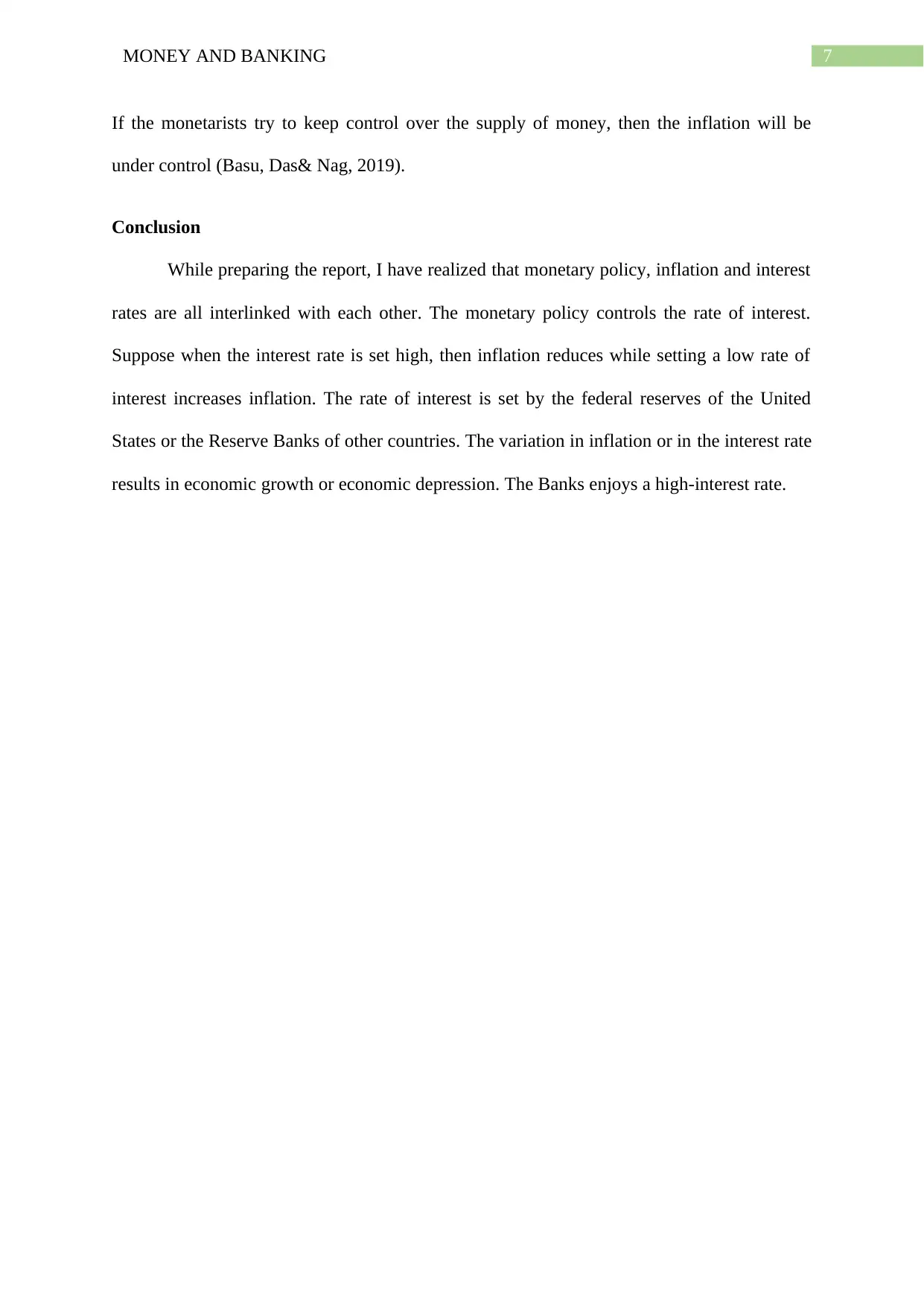
7MONEY AND BANKING
If the monetarists try to keep control over the supply of money, then the inflation will be
under control (Basu, Das& Nag, 2019).
Conclusion
While preparing the report, I have realized that monetary policy, inflation and interest
rates are all interlinked with each other. The monetary policy controls the rate of interest.
Suppose when the interest rate is set high, then inflation reduces while setting a low rate of
interest increases inflation. The rate of interest is set by the federal reserves of the United
States or the Reserve Banks of other countries. The variation in inflation or in the interest rate
results in economic growth or economic depression. The Banks enjoys a high-interest rate.
If the monetarists try to keep control over the supply of money, then the inflation will be
under control (Basu, Das& Nag, 2019).
Conclusion
While preparing the report, I have realized that monetary policy, inflation and interest
rates are all interlinked with each other. The monetary policy controls the rate of interest.
Suppose when the interest rate is set high, then inflation reduces while setting a low rate of
interest increases inflation. The rate of interest is set by the federal reserves of the United
States or the Reserve Banks of other countries. The variation in inflation or in the interest rate
results in economic growth or economic depression. The Banks enjoys a high-interest rate.
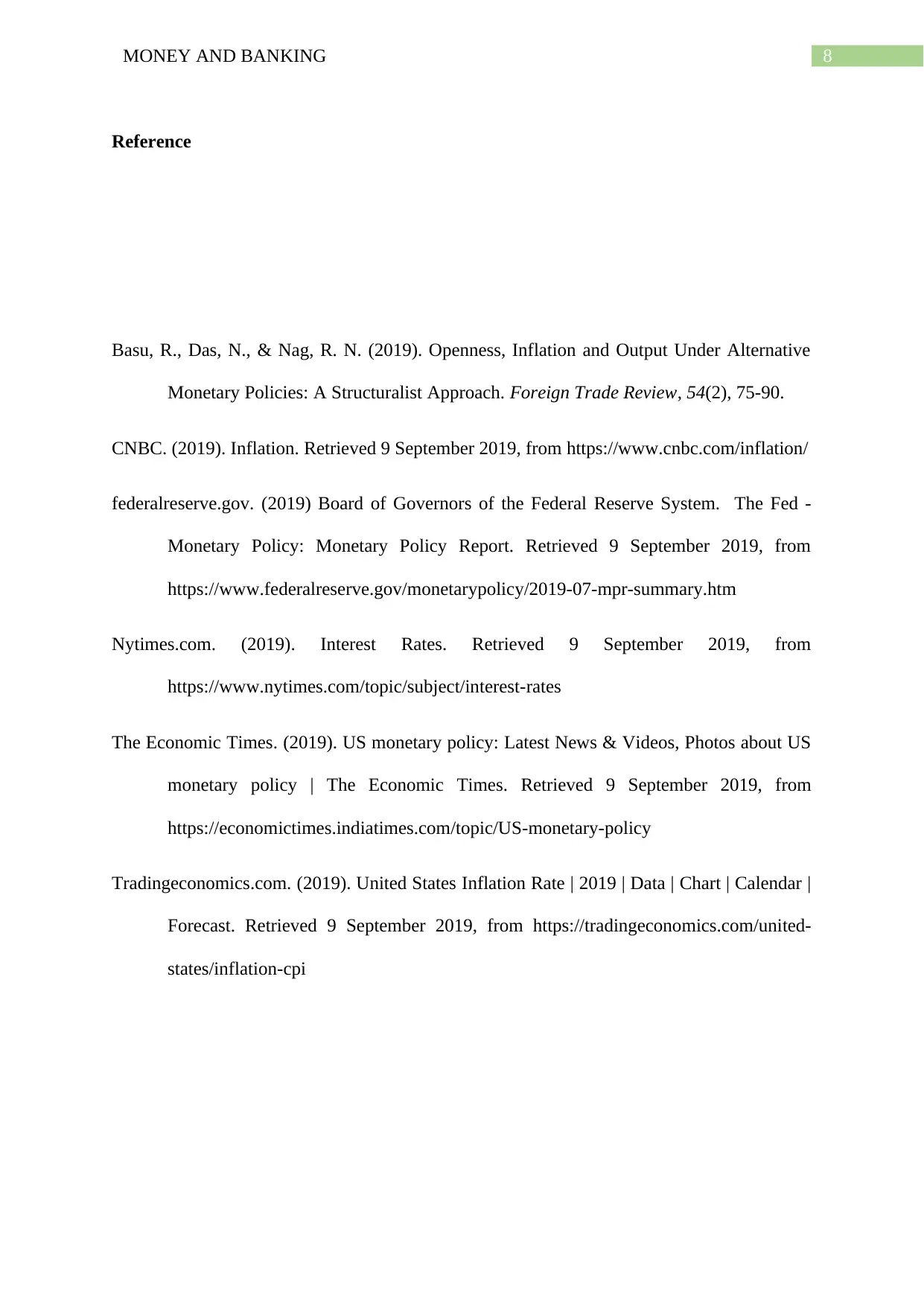
8MONEY AND BANKING
Reference
Basu, R., Das, N., & Nag, R. N. (2019). Openness, Inflation and Output Under Alternative
Monetary Policies: A Structuralist Approach. Foreign Trade Review, 54(2), 75-90.
CNBC. (2019). Inflation. Retrieved 9 September 2019, from https://www.cnbc.com/inflation/
federalreserve.gov. (2019) Board of Governors of the Federal Reserve System. The Fed -
Monetary Policy: Monetary Policy Report. Retrieved 9 September 2019, from
https://www.federalreserve.gov/monetarypolicy/2019-07-mpr-summary.htm
Nytimes.com. (2019). Interest Rates. Retrieved 9 September 2019, from
https://www.nytimes.com/topic/subject/interest-rates
The Economic Times. (2019). US monetary policy: Latest News & Videos, Photos about US
monetary policy | The Economic Times. Retrieved 9 September 2019, from
https://economictimes.indiatimes.com/topic/US-monetary-policy
Tradingeconomics.com. (2019). United States Inflation Rate | 2019 | Data | Chart | Calendar |
Forecast. Retrieved 9 September 2019, from https://tradingeconomics.com/united-
states/inflation-cpi
Reference
Basu, R., Das, N., & Nag, R. N. (2019). Openness, Inflation and Output Under Alternative
Monetary Policies: A Structuralist Approach. Foreign Trade Review, 54(2), 75-90.
CNBC. (2019). Inflation. Retrieved 9 September 2019, from https://www.cnbc.com/inflation/
federalreserve.gov. (2019) Board of Governors of the Federal Reserve System. The Fed -
Monetary Policy: Monetary Policy Report. Retrieved 9 September 2019, from
https://www.federalreserve.gov/monetarypolicy/2019-07-mpr-summary.htm
Nytimes.com. (2019). Interest Rates. Retrieved 9 September 2019, from
https://www.nytimes.com/topic/subject/interest-rates
The Economic Times. (2019). US monetary policy: Latest News & Videos, Photos about US
monetary policy | The Economic Times. Retrieved 9 September 2019, from
https://economictimes.indiatimes.com/topic/US-monetary-policy
Tradingeconomics.com. (2019). United States Inflation Rate | 2019 | Data | Chart | Calendar |
Forecast. Retrieved 9 September 2019, from https://tradingeconomics.com/united-
states/inflation-cpi
⊘ This is a preview!⊘
Do you want full access?
Subscribe today to unlock all pages.

Trusted by 1+ million students worldwide
1 out of 9
Related Documents
Your All-in-One AI-Powered Toolkit for Academic Success.
+13062052269
info@desklib.com
Available 24*7 on WhatsApp / Email
![[object Object]](/_next/static/media/star-bottom.7253800d.svg)
Unlock your academic potential
Copyright © 2020–2025 A2Z Services. All Rights Reserved. Developed and managed by ZUCOL.





